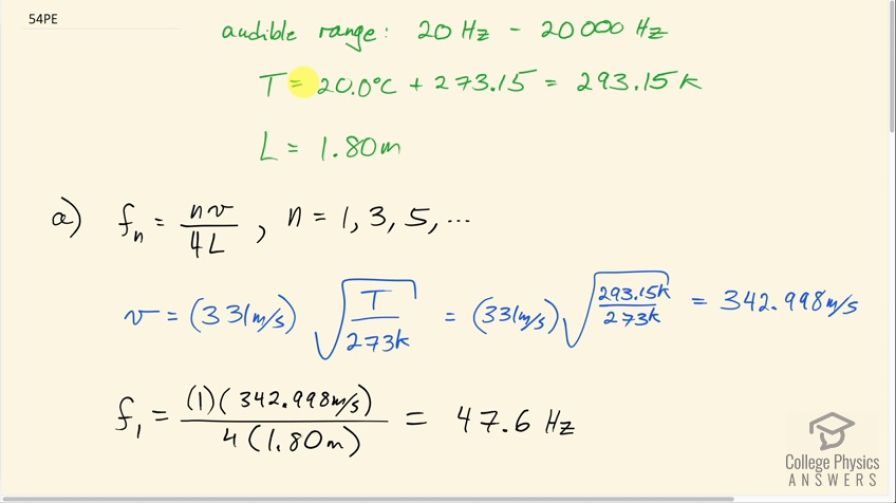Question
What frequencies will a 1.80-m-long tube produce in the audible range at if: (a) The tube is closed at one end? (b) It is open at both ends?
Final Answer
- to
- to
Solution video
OpenStax College Physics, Chapter 17, Problem 54 (Problems & Exercises)

vote with a rating of
votes with an average rating of
.
Calculator Screenshots
Video Transcript
This is College Physics Answers with Shaun Dychko. We are going to find out what audible frequencies will be produced by a tube that's 1.80 meters long and the air temperature is 20.0 degrees Celsius or 293.15 Kelvin with two different assumptions: in part (a), we assume that the tube is closed at one end in which case the nth frequency will be n times the speed of sound divided by 4 times the length of the tube where n is an odd, natural number— 1, 3, 5 and so on. First we have to find the speed of sound which is 331 meters per second times square root of the absolute temperature divided by 273. So that's 331 meters per second times square root 293.15 Kelvin divided by 273 which is 342.998 meters per second. The fundamental which will be the lowest end of the range of possible frequencies is going to be 1 for n multiplied by the speed of sound divided by 4 times the length of the tube 1.80 meters and that's 47.6 hertz. The maximum possible frequency that can be heard is 20000 hertz we assume and we will figure out what is the nearest number n that would give a frequency close to that. So f max is gonna be the maximum n times v over 4L and we can solve this for n max by multiplying both sides by 4L over v and so the n max is the maximum frequency times 4 times the length divided by speed of sound. So that's 20000 hertz times 4 times 1.80 meters divided by 342.998 and this gives 419.8 and numerically, this would round to 420 but that would cause a frequency that's slightly higher than 20000 hertz so let's assume that this is really the absolute limit; in that case, we have to round this down to 419. So we'll find out what is this maximum frequency it's gonna be 419 for n times the speed of sound divided by 4 times the length and that's 19.96 kilohertz. So the frequency range is anywhere from 47.6 hertz to 19.96 kilohertz. Okay! Now part (b) let's assume that it's the same length 2 but now it's open at both ends in which case the formula for the nth harmonic is n times the speed of sound divided by 2 times the length where n is any natural number. So the fundamental frequency is the speed of sound divided by 2 times the length of 1.80 meters and that's 95.3 hertz. And the maximum possible frequency we'll calculate by rearranging this to solve for n max multiplying both sides by 2L over v and we get the maximum n is 2 times the length times the maximum audible frequency of 20000 hertz divided by the speed of sound which is 209.9 and we have to round this to the nearest natural number that would cause a frequency below 20000 hertz and so we have to round this down to 209. So that makes the maximum frequency 209 times the speed of sound divided by 2 times the length which is 19.9 kilohertz. So the frequency range for a tube open at both ends of length 1.80 meters is 95.3 hertz to 19.9 kilohertz.



